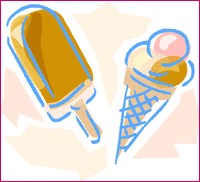Inventions: Food
Updated February 21, 2017 | Factmonster Staff 

Accidental Food Inventions
Great ideas that came from mistakes!

Do you ever feel bad because you made a mistake? Remember, some of our favorite foods were discovered by accident.
Popsicles
In 1905 an eleven-year-old Frank Epperson was mixing powdered soda and water to make soda pop. Frank accidentally left the mixing bucket outside. During the night the mixture froze solid, with the wooden stirring stick standing straight up. But the frozen pop tasted great! Frank started selling Epperson icicles for five cents, later changing the name to popsicles.
Sandwiches
|
One day in the 1700s, the Earl of Sandwich was so busy gambling, he did not want to go to eat. So, he ordered some food to be piled between two slices of bread, which he ate while gambling. The sandwich has been popular ever since
Chocolate Chip Cookies
In 1930, Ruth Wakefield was making chocolate cookies at the Toll House Inn in Whitman, Mass. When she ran out of baking chocolate, Ruth broke a bar of semi-sweet chocolate into little pieces and added them to the dough. When the cookies were baked, the chocolate hadn't melted. Instead there were little chips of chocolate throughout the cookie. Ruth was soon selling chocolate chip cookies.
Potato Chips

One day in 1853, a diner at Moon Lake Lodge in Saratoga Springs, New York, refused to eat an order of French fries because they were too thick. The chef, George Crum, fried a thinner batch, but the customer also rejected these. Crum decided to teach the diner a lesson. He sliced a potato paper-thin and fried it so heavily it could not be cut with a fork. But the customer loved them. Soon other customers were asking for potato chips.
Ice Cream Cones
Ernest Hamwi was selling Syrian pastry at the St. Louis World's Fair in 1904. When a nearby ice cream vendor ran out of dishes, Hamwi rolled some pastry into a cone so ice cream could be put inside. The ice cream cone was a huge a hit. However, an Italian immigrant named Italo Marchiony received a patent to manufacture ice cream cones earlier that same year, suggesting more than one person invented ice cream cones.
